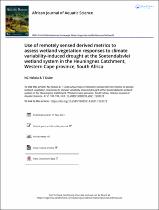| dc.contributor.author | Dube, Timothy | |
| dc.contributor.author | Ndlala, Noluthando | |
| dc.date.accessioned | 2022-08-02T09:11:08Z | |
| dc.date.available | 2022-08-02T09:11:08Z | |
| dc.date.issued | 2021-11-11 | |
| dc.identifier.citation | NC Ndlala & T Dube (2022) Use of remotely sensed derived metrics to assess wetland vegetation responses to climate variability-induced drought at the Soetendalsvlei wetland system in the Heuningnes Catchment, Western Cape province, South Africa, African Journal of Aquatic Science, | en_US |
| dc.identifier.uri | DOI: 10.2989/16085914.2021.1993778 | |
| dc.identifier.uri | http://hdl.handle.net/10566/7657 | |
| dc.description.abstract | Wetland vegetation plays an important role in the environmental functioning of wetlands through the provision of ecosystem services, such as food and critical habitat for organisms that live in or near water resources. The ecosystem services provided by wetland vegetation are facing several pressures due to the impacts of drought. Drought can induce significant declines in overall plant productivity and even lead to high rates of plant mortality. Therefore, assessing vegetation response to a drought is important for wetland assessment. In this study, the subtle changes in vegetation distribution were used as a proxy to examine and quantify the extent of drought impacts on the Soetendalsvlei wetland within the Heuningnes Catchment, South Africa. First, the vegetation health information was extracted by calculating the Normalized Difference Vegetation Index (NDVI) during the wet and dry seasons for the period between 2014 and 2018. The derived NDVI results were further statistically linked to the corresponding rainfall and evapotranspiration observed during the study period. An analysis of NDVI results revealed that gradual vegetation health change occurred across the study area. The highest derived NDVI (0.5) for
wetland vegetation was observed during 2014, but progressively declined over the years. Change in vegetation
health indicated a significant (r = 0.8–0.92) and positive correlation to the amount of rainfall received over the same
period, whereas with evapotranspiration the relationships showed an opposite trend (r = −0.7 to −0.5). The results
of this study highlight the importance of integrating remotely sensed data and climate variability information in
assessing wetland vegetation seasonal and long-term variations. Such information can help in decision-making on
the conservation of wetlands and effective monitoring of wetland ecosystems. | en_US |
| dc.language.iso | en | en_US |
| dc.publisher | Taylor and Francis Group | en_US |
| dc.subject | drought | en_US |
| dc.subject | evapotranspiration | en_US |
| dc.subject | NDVI | en_US |
| dc.subject | vegetation health | en_US |
| dc.subject | wetland extent | en_US |
| dc.title | Use of remotely sensed derived metrics to assess wetland vegetation responses to climate variability-induced drought at the Soetendalsvlei wetland system in the Heuningnes Catchment, Western Cape province, South Africa | en_US |
| dc.type | Article | en_US |

